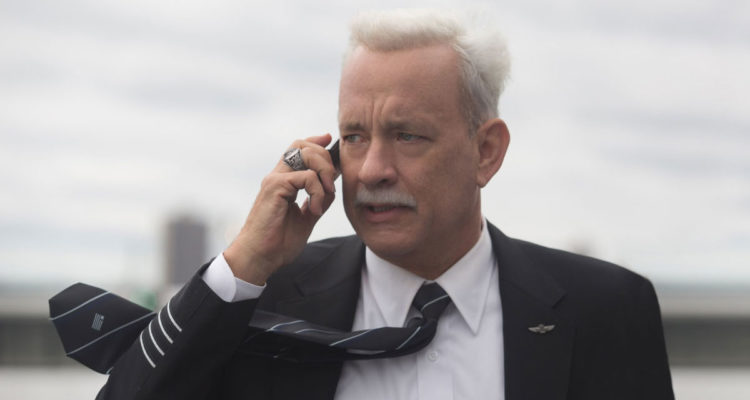TELLURIDE – When Capt. Chesley “Sully” Sullenberger made an emergency landing of the US Airways Airbus A320 he was piloting in the Hudson River he was declared a national hero. It was Jan. 15, 2009 and Flight 1549 had just taken off from New York’s LaGuardia Airport when a flock of birds knocked both engines out. Unable to make it back to LaGuardia or the other nearby landing strips he picked the best option at his disposal saving all 155 passengers and crew on board. He was on the cover of every newspaper across the country and a must-have interview for any major news network. What most Americans were unaware of was the tense investigation going on behind the scenes the week following the landing and the impact it had on both Sully and his First Officer Jeff Skiles. That’s the primary focus of Clint Eastwood’s “Sully” which premiered at the 2016 Telluride Film Festival Friday evening, but it’s not the best part of the movie.
READ MORE: Tom Hanks Is A Hero In New IMAX Trailer For Clint Eastwood’s ‘Sully’
Based on Sully’s own memoir “Highest Duty: My Search for What Really Matters,” which he co-wrote with journalist Jeffrey Zaslow, the picture begins with what we assume is the now legendary flight. As things begin to go wrong, Sully (Tom Hanks) and Nichols (Aaron Eckhart) find themselves somehow drifting over Manhattan unable to find a place to land. Shockingly, the flight becomes a literal nightmare as the plane crashes into the middle of the city. Sully then immediately wakes up, shaken by his nightmare. Even though everyone is alive and well the incident and what could have gone wrong is haunting him.

Still in New York City due to interviews with the National Traffic Safety Board, Sully is stressed. The NTSB says computer simulations have proved the plane had enough altitude to make an emergency landing at either LaGuardia or at the nearby Teterboro Airport in New Jersey. Sully and Nichols find this assumption ridiculous, but there is other evidence such as a sensor indicating that left engine was still operable that call into question the need for a water landing. With US Airways insurance company looking for an excuse to point to pilot error, any ruling against Sully and Nichols could jeopardize their careers. As the picture points out, however, the general public didn’t become aware of the investigation until weeks later. Sully was literally alternating celebratory media interviews (including an appearance on “The Late Show with David Letterman”) with an NTSB panel calling his actions into question. It’s not a true spoiler to reveal that eventually evidence is revealed that justifies the pilots chain of events.
READ MORE: New Photos Of Clint Eastwood’s Oscar Contender ‘Sully’ Starring Tom Hanks
Frankly, while well acted and nicely paced, the NTSB storyline plays out somewhat predictably. Where “Sully” truly soars is in Eastwood’s multiple depictions of the landing itself. Todd Komarnicki’s screenplay smartly teases a complete revelation of what occurred by cutting back to different moments during the incident as the NTSB plotline unfolds. For instance, Manhattan office workers jaws dropped as they the low flying plane cross over the city (evoking memories of Sept 11th that don’t need to be spoken). The cabin crew chanting at passengers “heads down, stay down.” Sully and Nichols surprised by the birds and immediately realizing something is very wrong. These moments all build to the final sequence that will have audiences catching their breath.

Before getting to the incident itself, Eastwood and Komarnicki up the stakes by introducing a number of passengers on that fateful flight to Charlotte, NC. There is the elderly woman and her grown daughter accompanying her. The father and his two adult sons, starting a long awaited golf trip, who are let on the plane on the last minute after another airline’s flight is canceled. And, of course, there is the experienced stewardesses who joke, “You know how to avoid delays at LaGuardia? Use JFK.”
After takeoff, the 200 or so seconds from when the plane lost its engines and hit the water are vividly recreated thanks to the cockpit voice recorder and numerous amateur videos that captured the incident. Most viewers know what happened that day, but Eastwood is able to create a wealth of tension by showing the point of view of air traffic control before the flight ended and during the evacuation of the plane itself. When a NY Waterway Ferry (a commercial vessel) heads to the scene and the FDNY rescue unit scrambles to rescue passengers Eastwood is pushing buttons like the old pro he is.

Hanks, his hair dyed stark white and looking somewhat older than Sully was at that time, doesn’t convey the folksy demeanor Sully has portrayed in public, but he does evoke his compassion. He’s particularly impressive after Sully is informed that all the passengers and crew made it out safely. The rest of the cast have their moments (Laura Linney in particular as Sully’s stressed out wife), but it’s really a showcase for Hanks’ charismatic demeanor.
In the end it’s really Eastwood who makes sure the film transcends the typical biopic tropes. At a spry 86 it’s unclear how much longer he’ll remain behind the director’s chair, but “Sully” proves that with the proper material and actors he can still stir emotions with the best of them. [B]
“Sully” opens nationwide and in IMAX on Sept. 9.
Click here for all of our coverage from the 2016 Telluride Film Festival.


